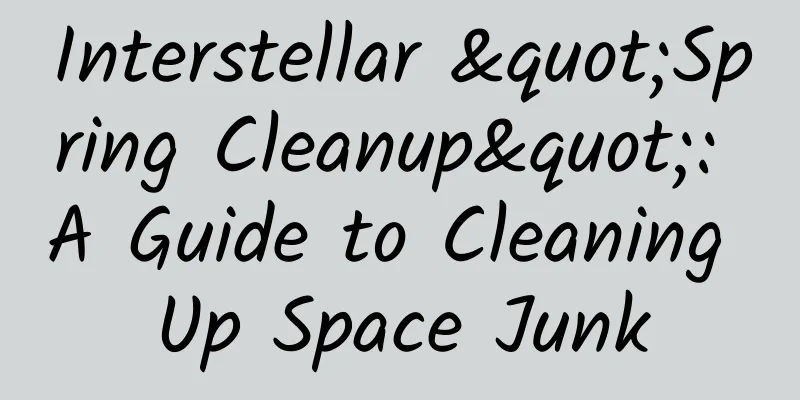Interstellar "Spring Cleanup": A Guide to Cleaning Up Space Junk

|
Three years ago, astronauts on the International Space Station discarded a two-ton pallet loaded with used batteries. Unexpectedly, part of the pallet returned to Earth after drifting in space for three years and smashed through a two-story building. The threat caused by space debris is not an isolated case. The International Space Station once took emergency maneuvers to avoid a piece of space debris. This emergency action directly interrupted the astronauts' original spacewalk plan and affected the later deployment of the space station. Where do these space debris with large-scale destructive power come from? Treasures left behind in the stars? Uncovering the origins of space junk On October 4, 1957, the Soviet Union launched the first artificial earth satellite, Sputnik 1. At this historic moment, another world record was born: after the satellite was successfully sent into space, its carrier rocket left the orbit and became the first piece of space junk in history. In the following decades, with the continuous advancement of science and technology and the deepening of space exploration, various satellites, manned spacecraft, unmanned probes and other spacecraft were frequently sent into space. The launch process of these spacecraft, as well as their operation, maintenance and eventual scrapping in space, inevitably produced a large amount of space debris. These debris include rocket parts that failed to burn or separate completely, satellite bodies abandoned after completing their missions, fragments of solar panels, and even tiny objects such as screws that fell off during the mission. To complicate matters further, space is not a silent vacuum. Despite its extremely low density, there are still a large number of tiny celestial bodies, such as meteoroids and asteroid fragments. These celestial bodies move at high speeds near Earth's orbit and occasionally collide with spacecraft in orbit. Once a collision occurs, it will not only damage the spacecraft itself, but also generate more debris, which will become a potential source of danger and increase the risk of future collisions. Space junk Cosmic threats: the dangers of space junk With the increasing frequency of human space activities and the continuous accumulation of space debris, space, once regarded as an infinitely vast field, is quietly becoming increasingly "crowded". Spacecrafts not only have to face the complex space environment when shuttling between them, but also have to be vigilant against space debris. If these space debris collide with satellites or spacecraft that are operating normally, they are likely to cause damage to them. If they encounter manned spacecraft, they will also threaten the lives of astronauts and cause serious consequences. At present, the low-Earth orbit (LEO) area is full of a large number of space debris, reaching millions. These fragments move at extremely high speeds, reaching 29,000 kilometers per hour, which is about seven times the speed of a bullet. In view of this, even tiny space debris has enough kinetic energy to penetrate astronauts' space suits or damage satellites' solar panels and electronic components. Although according to data provided by the European Space Agency (ESA), the risk of humans living on Earth being injured by space debris is less than one in 100 billion, which is much lower than the chance of winning a large lottery jackpot, the potential hazards caused by space debris are still worthy of attention. Space junk collides with spacecraft Operation Space Cleanup: How to Save Our Interstellar Home There are currently four approaches to space junk: avoidance, prevention, protection and cleanup. Avoidance is to use high-tech orbit monitoring technology to know the location of space debris in advance, so that our spacecraft can take a detour and try to avoid hitting them. Prevention is to set up end-of-life deorbit measures for satellites. When the satellite enters the end of its life, the satellite's attitude orbit engine will start, actively lowering the satellite's orbit and allowing it to enter the atmosphere faster, thus reducing the generation of space debris. For those satellites in geosynchronous orbit, they can be sent to the "graveyard" orbit, which can also have the effect of reducing space debris in commonly used orbits. Protection is to resist the impact of space debris by putting on "bulletproof vests" such as aluminum plates and high-strength composite materials on spacecraft. Cleaning is to pull the garbage into the atmosphere and let them burn, or raise the orbit of space debris to an uncommon orbital altitude. Drag space junk into the atmosphere to burn up or drag it to a "graveyard orbit" On June 25, 2016, China's Long March 7 rocket made its maiden flight, sending seven payloads into space, one of which was the Aolong-1 space debris cleaning vehicle. It is like a space cleaner, using its mechanical arms to grab the surrounding space junk to achieve the purpose of cleaning. Laser technology is an advanced technology that is currently widely used in various fields. When cleaning up space debris, lasers can be like a magic wand, gently pushing the space debris to change their flight path so that they will not hit important space equipment. Lasers can also be aimed at space debris to let the heat of the laser burn or melt the debris. However, there are some difficulties in using lasers to clean up space debris, such as the need to control the direction and intensity of the laser very accurately, and to be careful that the laser may be bounced back by space debris. Laser cleaning up space junk In addition to laser technology, a technology called electromagnetic protection can also be used to clean up space debris. It can use electromagnetic fields to change the flight path of space debris. Just like when we put a small piece of iron next to a magnet, the iron sheet will be attracted to it. Electromagnetic protection also uses a similar principle, but in space, electromagnetic fields are used to attract the iron sheet, change its direction, and even "lock" it up and send it to a safe place. However, due to the high cost and complexity of this technology, it is still very difficult to fully apply it. In addition, some scientists have also drawn inspiration from fishing with fishing nets in our daily lives and come up with a special method to clean up garbage in space - flying net capture. The special thing about this flying net is that its structure is very sparse, and only a small amount of material is needed to cover a large area after it is unfolded. A flying net weighing only 3 kilograms has an area of nearly 1,000 square meters after unfolding. This design allows the flying net to capture satellites and large pieces of space debris in space without high precision. Moreover, no more debris will be generated during the use of the flying net, which improves safety. Space debris may pose a threat to satellites and other space assets in orbit, increasing the risk of space missions, so it is necessary to control it from the source, improve the sustainability of space technology, use environmentally friendly materials, strengthen monitoring, and clean up failed equipment in a timely manner. Space is the common property of all mankind, and protecting the space environment requires joint efforts and cooperation among countries. Some information comes from People's Daily Online, CCTV.com, International Online, etc. (Scientific review: Yin Rui, Deputy Commander-in-Chief of the Astronaut System of China's manned space program) |
<<: Whoosh! Whoosh! Whoosh! How should spacecraft respond to micrometeoroids and space debris?
>>: Why do people still get shorter as they age? "Height reduction" may be related to these reasons
Recommend
How are well-known educational institutions using short videos to make famous teachers famous?
2019-2020 is a period for short video creators in...
What is the timetable for the 2022 Beijing College Entrance Examination? What month and date is the exam?
The 2022 Beijing College Entrance Examination wil...
How much is the investment price for the Shigatse agricultural products mini program? Shigatse Agricultural Products Mini Program Merchant Price Inquiry
How much does it cost to attract investment for t...
NASA finally admits! Going to Mars is to search for alien life
As to whether there is extraterrestrial life in t...
Nature News: AI beats human mathematicians to solve classic mathematical problems for the first time
Artificial intelligence (AI) big models beat huma...
Why can doctors diagnose health problems just by looking at the person’s walking?
A friend told Huazi a "miraculous thing"...
Remember to look up recently! This life-threatening journey is about to begin
I am a bird-watching enthusiast. However, sometim...
12 Ways to Attract New Customers in the Education Industry
Regardless of the industry, attracting new custom...
Deployment of mobile terminal chips to promote the independent development of 4G industry
Mobile communications is a strategic emerging ind...
What are the functions of Lanzhou’s elderly care mini program development? How much does it cost to make a mini program?
At present, the elderly population in my country ...
Can eating rice like this help you lose weight? Are you tempted?
I heard that cooling down cooked rice, steamed bu...
The only semi-annual review of WeChat Mini Programs personally compiled by Zhang Xiaolong!
This will be the only article that deeply interpr...
Introduction to Huawei App Market paid promotion process and resource positions!
Introduction to Huawei AppGallery Paid Promotion ...
Please check this cybersecurity checklist!
The 2022 National Cyber Security Publicity Week...
How to improve the conversion rate of APP landing page?
Landing page quality and user matching are two ke...









